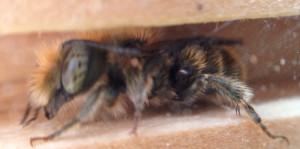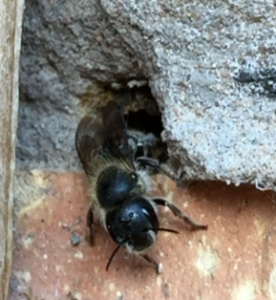Red and Blue Mason bees nesting in same nest box
With Red mason bees and Blue Mason bees living together in the same Nurturing Nature solitary bee observation nest box, it’s like Liverpool and Everton supporters living together, which is great!! Besides Red masons, 2 species of leafcutter bee, Osmia Leaiana and wool carder bees (2016) using my nest boxes, I have had many attempts by the Blue mason bee to nest, but they have never been successful. They have all started by creating a back wall in a cavity, made from masticated plant material, even if the cavity itself is already sealed further down. I suspect its another maternal protection behaviour as an added feature against predation. They always select my smallest sized cavities and not the Red mason bee cavities. They line the cavity with masticated plant material and have died or abandoned the nest. This year, again I had several attempts to nest in other nest boxes, now, at last, I have at least one larva inside a nest box which I can view. Not checked out all my brick walls yet!
I had several males resting overnight which is quite usual. The gingerish hairy bodies of the males appear to emphasise the mottled green eyes. I have often seen several females. I think they must nest somewhere else, perhaps near to where they emerged from? They will nest inside holes in walls as you will see in the video.
I often see these small bees in the garden, but they are never very numerous. The females mostly use green plant material, but will also use flower petals such as poppy, mallow or possibly rose to seal their cavities. Although these bees are capable of two generations a year, in my garden I usually see them flying in early to late summer. I suspect the temperatures have bearing on this aspect.
“All my articles and videos, available free, are funded by my presentations and sales of award-winning bumblebee nest boxes, solitary bee boxes, and wormeries. Please help by spreading the word and forwarding this link to your friends and colleagues. https://nurturing-nature.co.uk Thank you” George Pilkington
The females are a very deep blue/black colour and have white hairs on their bodies, so they do look quite different from each other. I suspect the female above was one of several using the toadflax in my garden, which they loved.
I suspect they are Blue Mason bees, visit BWARS Blue Mason bee and see what you think!
For info and link to buy an excellent book Field Guide to the Bees of Great Britain and Ireland by Steven Falk
An extremely useful resource supports this book by a special website feature within Steve Falk’s Flickr website which furnishes extra photos and other useful resources to assist with identification.
Solitary Bees book by Ted Benton
Interested in Citizen Science and pollinators? The Buzz Club



Hi George.
Do you ‘harvest’ your cocoons or leave them in situ for the bees to make their own way out of the box? I have a couple of lines of mason bee cocoons and a line of leaf cutter. I want to try and maximise the number of successful bees that appear.
I do Alan, keep them separate and keep them away from mice! Cheers, George